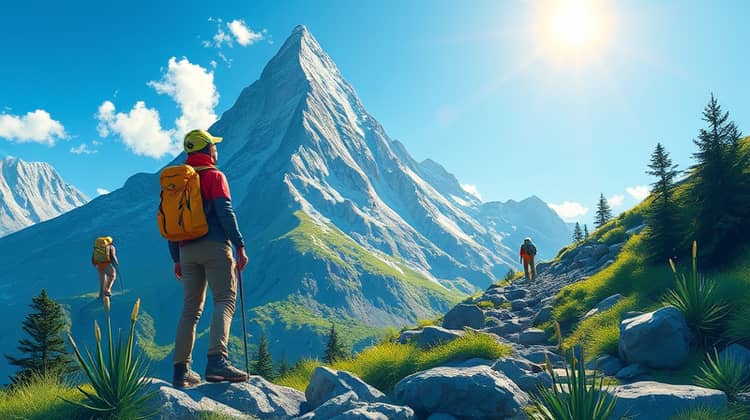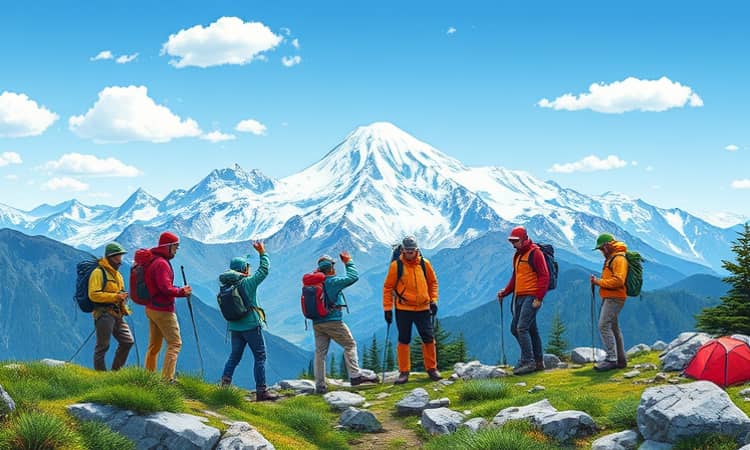Mountain climbing is an exhilarating activity that offers an escape into the great outdoors while testing your physical and mental limits. However, embarking on your first mountain climb requires careful preparation and the right mindset. Whether you're dreaming of reaching breathtaking summits or simply enjoying the views from a secluded peak, being well-prepared is crucial to your success and safety.
In this guide, we will walk you through the essential steps to prepare for your first mountain climb. From understanding the basics of climbing to ensuring you have the right gear and training, each section will provide valuable insights and tips to help you on your journey. By the end of this article, you'll be equipped with the knowledge needed to tackle your first climb with confidence and enthusiasm.
So lace up those hiking boots, and let’s begin this adventure together!
1. Understanding the Basics of Mountain Climbing

Mountain climbing is an adventure that combines physical endurance, mental fortitude, and the joy of nature. Before you set off on your journey, it’s vital to familiarize yourself with the fundamental concepts and techniques of climbing. This knowledge will not only enhance your experience but also ensure your safety.
At its core, mountain climbing involves ascending steep terrain, which can vary from hiker-friendly paths to technical rock faces. Climbers often use gear such as ropes, harnesses, and climbing shoes to assist them in their ascent. Understanding the different types of climbing—like traditional, sport, or alpine—is essential to select the right approach for your planned climb.
2. Choosing the Right Mountain

Selecting the right mountain for your first climb is equally as important as preparing yourself physically and mentally. Consider starting with beginner-friendly peaks that offer accessible trails and manageable altitudes. Research local mountains that provide varied landscapes and are known for being beginner-friendly to build your skills and confidence.
Aside from the technicalities, consider the environmental factors, such as weather conditions and the season. Some mountains might be better suited for climbing at certain times of the year due to snow, rain, or extreme temperatures.
- Research beginner-friendly mountain ranges.
- Check local hiking forums and reviews for recommendations.
- Choose a mountain that matches your fitness level.
3. Essential Gear and Equipment

Having the right gear is an essential part of preparing for your climb. The right equipment not only enhances your performance but also keeps you safe on the trails. Start with the basics, including sturdy hiking boots, breathable clothing, and a reliable backpack to carry your gear.
In addition to basic clothing and footwear, here are some essential gear items you should consider packing for your mountain climb:
- Water bottle or hydration system
- First aid kit
- Map and compass or GPS device
- Climbing harness (if necessary)
- Headlamp or flashlight
- Snacks for energy
4. Physical Training and Conditioning

To successfully tackle a mountain climb, physical preparation is key. Start a training regimen at least a few weeks in advance to build your endurance, strength, and flexibility. This can include a mix of cardio exercises, strength training, and flexibility workouts like yoga or stretching.
Walking or hiking on varied terrains, especially inclines, will prepare your legs for the physical demands of climbing. Additionally, practicing climbing techniques at a rock climbing gym can greatly enhance your skills before hitting the trails.
5. Acclimatization and Altitude Sickness

As you venture to higher altitudes, acclimatization becomes crucial. Your body needs time to adjust to lower oxygen levels to avoid altitude sickness. It's a good practice to ascend slowly, allowing your body to adapt before reaching higher elevations.
Watch for symptoms of altitude sickness, which can include headaches, nausea, and dizziness. If you start feeling unwell, it's essential to descend to a lower altitude immediately.
- Ascend slowly to give your body time to acclimatize.
- Stay hydrated to combat altitude effects.
- Take breaks to rest and recover.
6. Safety Measures and First Aid

Safety should always be your top priority when climbing mountains. Familiarize yourself with basic first aid skills and carry a well-equipped first aid kit. Knowing how to respond to injuries or emergencies can significantly impact your safety and the safety of your climbing companions.
Before heading out, inform someone about your climbing plans, including your estimated return time. This ensures that if something goes wrong, someone will know to look for you.
- Learn basic first aid skills.
- Carry a first aid kit that includes supplies for cuts, sprains, and altitude illness.
- Always inform someone about your climbing itinerary.
7. Climbing Techniques

Understanding different climbing techniques can greatly enhance your efficiency and safety on the mountain. Techniques vary based on the terrain, with hiking, scrambling, and technical climbing each using different methods and gear.
Practice using equipment like climbing ropes, carabiners, and harnesses in a controlled environment before heading to the mountain. Familiarity with these techniques will make the actual climb smoother and more enjoyable.
- Hiking for gentler slopes.
- Scrambling for rocky terrain.
- Using knots and harnesses for technical climbs.
8. Leave No Trace Principles

As climbers and outdoor enthusiasts, it's our responsibility to protect the beautiful landscapes we explore. Following the Leave No Trace principles minimizes our impact on the environment and ensures that these natural areas remain intact for future generations.
These principles include planning ahead, sticking to trails, disposing of waste properly, and respecting wildlife. Always be mindful of your actions and their impact on nature.
9. Weather and Environmental Considerations

Weather conditions can make a significant difference in your climbing experience. Before you set out, always check the weather forecast for your climbing area, and be prepared for sudden changes. Mountain weather can shift rapidly, so it's essential to stay informed and adaptable.
Bring appropriate clothing for varying conditions, including layers for warmth, a waterproof jacket, and sunscreen to protect against UV rays at altitude.
- Check weather forecasts before your climb.
- Bring extra layers and rain gear.
- Stay informed about potential weather shifts.
10. Mental Preparation

Climbing is as much a mental challenge as it is a physical one. Prepare yourself for the mental demands of the climb by setting realistic expectations and visualizing your success. Positive thinking can significantly influence your performance.
Practicing mindfulness and staying aware of your surroundings can enhance your climbing experience. Learn to focus on the present moment, which can help throughout the ascent and descent.
11. Hiring a Guide or Joining a Group

If you're unsure about climbing alone or want a more supported experience, hiring a guide or joining a climbing group can be beneficial. Experienced guides can provide valuable insights, support, and ensure safety on the mountain.
Climbing groups can also enhance your experience. Sharing the journey with others fosters camaraderie and mutual support, making the climb even more enjoyable.
12. The Climb: What to Expect

As you embark on your climb, expect a mix of excitement and challenges. Each ascent can vary based on the mountain and conditions, but it's essential to pace yourself and take breaks when needed. Remember that the journey is just as important as the destination.
Be prepared for varying terrains, possible weather changes, and the physical demands of climbing. Embrace the beauty of nature, share the experience with fellow climbers, and celebrate each step you take towards the summit.
Conclusion

Preparing for your first mountain climb is an enriching journey in itself. By understanding the basics, choosing the right mountain, and training appropriately, you set yourself up for a rewarding adventure that connects you with nature and challenges your limits.
Remember, every climber was once a beginner, and with time, effort, and the right preparation, you'll not only reach your first summit but also cultivate a deep appreciation for the mountains and outdoor adventures that await you.














